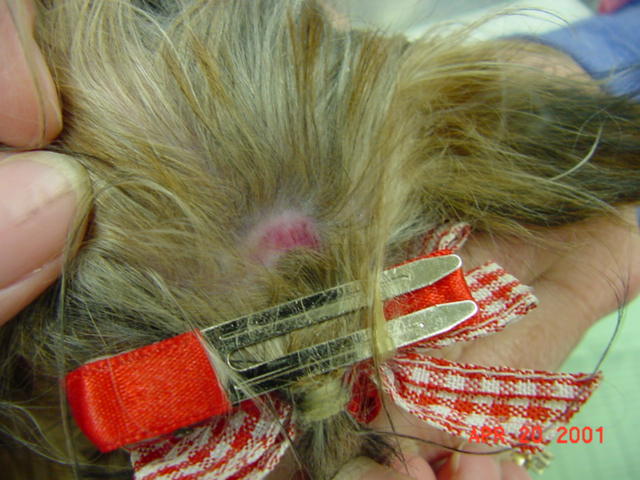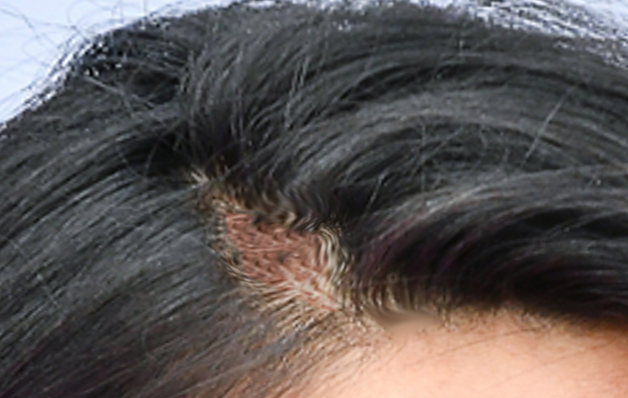Continuing Education Activity
Traction alopecia results from continuous pulling force on the hair roots. It usually occurs in women of African descent who have tight, spiral curling hair. Traction alopecia is preventable. This activity reviews the evaluation and management of traction alopecia and highlights the role of interprofessional team members in collaborating to provide well-coordinated care and enhance outcomes for affected patients.
Objectives:
Identify the cause of traction alopecia.
Explain the population most at risk for developing traction alopecia.
Explain how to prevent traction alopecia.
Explain the importance of improving coordination amongst the interprofessional team to enhance the delivery of care for patients affected by traction alopecia.
Introduction
Traction alopecia occurs in individuals having hairstyles that produce a continuous pulling force on the hair roots. It usually occurs in women of African descent who have tight and curly spiral hair. Traction alopecia is preventable, with appropriate education, it could be eliminated.[1][2][3]
Etiology
Traction alopecia (TA) is hair loss due to repetitive tension on the hair.
Epidemiology
Traction alopecia is a common occurrence in Afro-Caribbean hairstyles which involves tight braids. Problems typically start in childhood, where they may initially be reversible. TA is “biphasic” with early disease nonscarring and reversible, whereas chronic disease is scarring and permanent. Population data from South Africa demonstrates it occurs in both children and adults. In this population, TA is ubiquitous in females with up to one-third (31.7%) of adult women showing hair changes. In children of age between, six to 15, the prevalence of this disease ranged from 8.6% to 21.7%. In a study, among African American girls aged 5.4 to 14.3 years, 18% showed signs of TA. The prevalence is also higher in African schoolgirls than boys (17.1% versus 0%) and is higher in females as compared with males (31.7% versus 2.3%, respectively); with affected men more likely to wear cornrows and dreadlocks. The youngest reported case of traction alopecia is a child of eight months of age. Although it is seen in school-aged children, the prevalence increases with age and is highest among adult women.[4]
Pathophysiology
Although TA occurs is commonly seen in women of African descent who have tight spiral black hair, it has been suggested from recent studies that the main risk factor for traction alopecia is the associated hair care practices and not the hair types. It is thought that chronic traction could affect the dermal papilla thus leading to a diminution of the hair follicle.
Histopathology
Traction alopecia exhibits variable features in the histopathology depending on the stage of the disease. The early stage is characterized by an increased number of telogen and catagen hair follicles, with a normal number of hair follicles and trichomalacia (soft fragile and swollen hair). This is followed by drop-out of the terminal hairs and retained smaller-caliber hairs along the frontotemporal hairline reflected as vellus hairs. In later stages of traction alopecia, there is a decrease in the terminal follicle count which is replaced with fibrotic fibrous tracts. There is a characteristic absence of any inflammatory infiltrate at any time during the course of this disease.
History and Physical
Traction alopecia is condition seen commonly associated with Afro-Caribbean hairstyles like tight braids. The onset of hair loss occurs commonly in the temporal regions, preauricular region and above the ears but may involve other parts of the scalp, particularly where "corn row" patterns are adopted. The other findings that may also occur include folliculitis, hair casts, reduction in hair density and replacement of few with vellus hairs and the occasional presence of broken hairs in the affected areas, which finally proceeds to alopecia that leaves scars. It can be associated with a headache, relieved when the hair is loosened. The pattern of the alopecia is characteristic and reflects the distribution of the traction. Problems typically start in childhood, where they may initially be reversible. A degree of temporal thinning may also be part of a genetic hair pattern seen in those with no traction. Ponytails, hair twisting in Sikh boys, and tight scarf styles can all result in hair loss. Common hair care practices that involve tension are ponytails/pigtails, chignon, braids, cornrows, twists, sister locks, dreadlocks, weaves, extensions, and curlers.[5][6][7]
On examination of the scalp, TA manifests with hair loss usually along the marginal hairline (frontal, temporal, or occipital) with decreased retained follicular markings and the presence of a “fringe” of finer, or miniaturized hairs. The characteristic finding is the retention of hair follicles of lesser diameter along the frontal and/or temporal hairline. This sign is called the 'fringe sign, ' and it correlates with the presence of vellus hairs seen in the histology. The presence of hair casts is a sign of ongoing or persistent TA. Linear, curved, or geometric patterns of lost hair should alert the clinician to the possibility of TA. Body hair, eyebrows, skin, and nails are unaffected in TA.
Evaluation
The severity of traction alopecia is assessed by using the Marginal Traction Alopecia Severity Score (M-TAS). This is a validated photographic scale used to ascertain the severity of marginal TA. Anterior and posterior hairlines are localized using anatomic landmarks and are graded on a scale of 0 to 9. The scale has been used in clinical studies to correlate disease severity with potential risk factors for TA. Potentially, the M-TAS may be a useful tool used to monitor response to treatment. Dermoscopy can be a useful aid in the diagnosis of TA. The presence of hair casts is typical of traction alopecia. In patients with a patchy and marginal type of alopecia secondary to traction, a reduction in the density of hair follicles, the absence of follicular openings and the presence of a large number of freely mobile hair casts at the periphery of the patch is seen on dermoscopy. In the patient with a diffuse type of alopecia secondary to traction, dermoscopy reveals a normal density of hair with numerous hair casts. The hair casts due to traction alopecia are nonadherent, white or brown in color, cylindrical in shape and tend to encircle the proximal hair shaft.[8][9]
Treatment / Management
Treatment of traction alopecia is based on factors like the chronicity of the disease and presence and absence of permanent alopecia. The treatment is decided by the stage of the disease. For practical purposes traction alopecia has been classified into three stages namely stage of prevention, stage of early traction alopecia and stage of longstanding traction alopecia.[10][11]
In the stage of prevention, the strategies include educational messages for parents, children, adolescents and young adults, about hair care practices. This intervention is significant as hair follicles are most vulnerable during this period.
In the stage of early traction alopecia, when the follicular units are still intact, the strategy is aimed at reduction of the hair tension by use of hairstyles which reduce the tightness of the braid. Other strategies include complete avoidance of chemicals or heat and brushing the affected area. The use of topical or intralesional corticosteroids is recommended if there is an evidence of inflammation, in the form of scaling or erythema or tenderness in the scalp. The use of intralesional triamcinolone to the peripheries of the hair loss is advocated in such cases. Pustules may be treated with oral or topical antibiotics, considering their anti-inflammatory effect.
In long-standing disease stage, surgical options are the viable option considered. Hair transplant using techniques like micro-grafting, mini-grafting, and follicular unit transplantation is found to be effective. A novel therapy using alpha-1 adrenergic receptor agonists in the management of traction alopecia has been recently explored. The suggested hypothesis here is that alpha-1 adrenergic receptor agonists induce contraction of the arrector pili muscle thus increasing the force required to pluck the hair. Hence topical phenylephrine- a selective alpha-1 adrenergic receptor agonist has been tried for traction alopecia. It was found that this medication reduced hair loss secondary to traction in one study involving a sample of female patients. The same study also found that the threshold of traction required in causing epilation increased after the application of topical phenylephrine.
Differential Diagnosis
Enhancing Healthcare Team Outcomes
Traction alopecia is quite common in women and usually occurs in individuals having hairstyles that produce a continuous pulling force on the hair roots. It usually occurs in women of African descent who have tight and curly spiral hair. The dermatology nurse and clinician should work together to educate the patient as traction alopecia is preventable, and with appropriate education, it could be eliminated. [Level V]


